11 Running Tips and Techniques from a Veteran Distance Runner
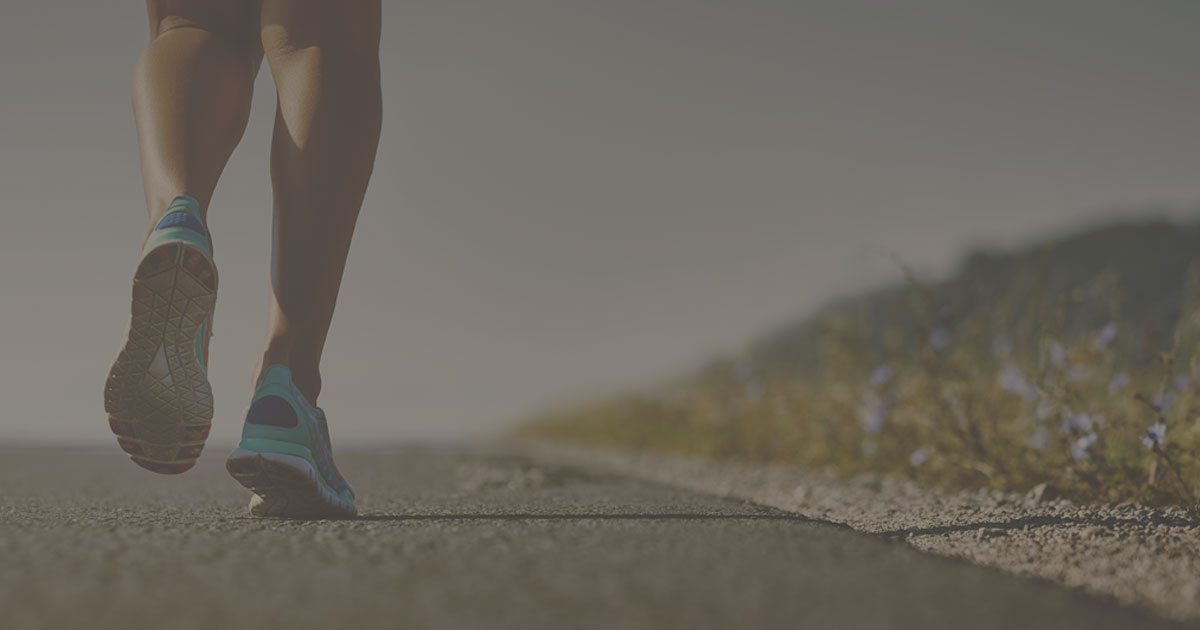
Hello fellow runners!
My name is Tori McCoy and I am one of the Athletic Trainers with Performance Therapies. When I first started running (about 5 years ago) I never imagined myself getting into distance running, so I participated in many different short races and 5Ks. My first long distance race was about 3 years ago, when my sorority asked me to represent them in the Half Marathon Red Shoe Run to benefit the Ronald McDonald House of Iowa City. After that, I ran the Chicago Marathon with one of my favorite organizations – Dance Marathon.
Both the training and the race was a lot harder than what I anticipated, but I wanted to prove to myself that I could do it. Then, somehow, I got running fever and I ran 2 more half marathons (both Red Shoe Runs) and 3 more marathons (Chicago, Des Moines and now Run CRANDIC). Over this time I have learned A LOT about running and I have also coached others (in charities) how to become efficient runners by helping them answer some of these common beginning runner questions.
Question: Can I walk during my runs?
Of Course! Not everyone is built to RUN a full half marathon or marathon! For runners that are just starting, this is a good way to ease into longer miles. This will also prepare the body for the big commitment of running 13.1 miles or more. Easing into it will also help save you from injury and good old shin splits. Remember its about making it to the finish line, NOT about how fast you get there. I myself use the run-walk method when running. My past two marathons I have used the run-walk method and have increased my race pace. My body can comfortably run six miles but I give it a small break after that by walking for a bit. To me it feels like my muscles can recharge and get ready for my next 6 miles. I also found that once I switched to this method I feel a lot better at the finish and post marathon.
Question: How should I be breathing?
Well, this one was hard for me to fully get down. As a runner, you use a lot of muscles for a longer period of time, which means that the muscles need a lot of oxygen. I have always heard to strictly breath in through the nose and out through the mouth, but that can feel uncomfortable and unnatural for the body. I breathe in and out of both my nose and mouth. BUT the key to getting the most beneficial breathing, is to breathe from your belly and not just your chest. Belly breathing will fill the lungs up to a higher capacity then just breathing with the chest.
Question: How do I get over feeling self-conscious?
This all depends on what is making you feel self-conscious. When I first started running I felt self-conscious because I don’t run that fast. I NEVER use to run before college and this was my first shot at it. What helped me the most was self talk and staying motivated to run. Self talk is a great tool to boost your confident levels and keep you motivated to run. Essentially my thought process was; the only way to get good at something is to practice, so the more I practice the better I’ll be at running and the better I am at running the faster I will get.
If your self-conscious about something (speed, how you look while running, your weight, etc.), I think the best thing to do is to talk yourself up, because you are about to do something incredible. Not everyone can run, because running is hard. And even less people run a half or a full marathon. So be proud! Have confidence! And keep running!
Question: How fast should I be running?
This depends on a couple of things; what finish time you would like and what your body will allow. I recommend if you are a beginning runner and this is your first half or full marathon to aim for completing the marathon or pick a generous time. This is because you are going to be experiencing everything for the first time: the race atmosphere, how your body will feel running, water intake, carbohydrate intake all during the race, and more. This is also a good first stepping stone to see where you need to improve for future marathons. With that being said, I am not saying to walk the whole thing-I mean you can if you want-but push yourself during your training. Listen to your body. Feel when you are going too fast or feel when your are taking it too easy. Find a comfortable pace and work from there.
Question: How do I run on different terrain?
Up Hills:
Look ahead, shorten your stride, stay tall, and stay on pace. This will most effectively use your body and the energy that is needed to get you up the hill at your race pace. So don’t lean forward and look down!
Down hills:
Lengthen your stride, stay tall and stay on pace. The battle with going down hill is not to lengthen your stride to much. If you make your stride to long it will cause you to touch ground with your heel first which actually slows you down.
Trail Running:
This is always a little bit different. Keep looking forward and be aware of the terrain. Focus on sturdy stops-don’t focus on all the bad/uneven spots. Make sure to keep form when running on this uneven terrain.
Remember to try to keep the upper body relaxed when battling these obstacles. Always stay tall and try to hit the mid foot first (this could take sometime to get use to but it’s worth it). Below are a couple of examples to give you a better picture.
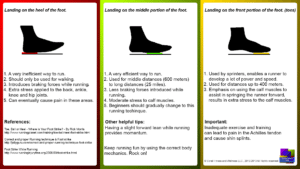
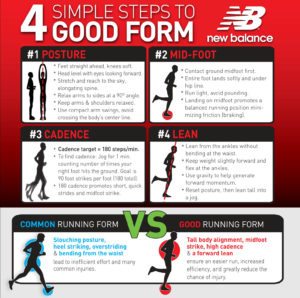
Question: What should I expect during a half marathon or marathon, soreness wise?
This all depends on how much and how well you trained. My very first half marathon I DID NOT TRAIN and I was miserable after the race for a couple of days. But I learned my lesson and trained for all my races after that moment. A half marathon, you should expect a little bit of soreness toward the end and upon finished your legs will feel like jello-but keep moving and don’t sit once you finish. As for the marathon, there is one moment that you may experience even if you train really well-it’s called “the wall”. I will not sugar coat it, but you will be uncomfortable during this period. Some people get it worse than others. My biggest advice for both the half and the full-KEEP MOVING!
Question: Should I eat before I run?
Yes! Even if it is something light! Your body is burning A TON of calories while you are running and it needs to be replenished. I eat something small that I know doesn’t weight me down while I am running. I like to run in the morning after breakfast so I usually eat something like peanut butter toast with a fruit smoothie. If I do manage to run in the evening, I will have a light meal (like a SMALL bowl of pasta) then eat a bigger meal once I am finished running.
One really good resource for beginner runners when it comes to diet and eating while training is Nancy Clark’s Food Guide for Marathoners. I found this book unbelievably helpful when I was first getting into running. It has great information on a little bit of everything.
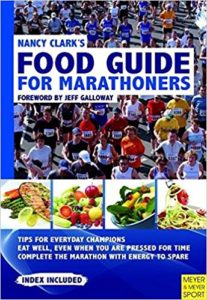
Question: How can I improve my speed for a better finish time?
The best two ways to improve speed are tempo runs and cross training. Tempo runs are designed to have runners push themselves and have many different forms. These runs combine fast/race pace and recovery pace in one run. Here is my 5 mile tempo run for an example:
- Warm Up: 10 min
- Mile 0-1.5 run marathon pace
- Mile 1.5- 3 recovery pace
- Mile 3-4 run marathon pace
- Mile 4-5 run slightly faster than marathon pace
- Cool down: 10 min
Cross training is important to help with strengthening muscles, which will then help the muscles create more power-making your race pace faster. Cross training is also important to help with injury prevent.
Question: Should I run every day?
NO! Your body needs time to recover! I would recommend running four to five days a week. When training for a half or a full, a training program should have at least one long run, a recovery run, and some tempo runs. These all have a purpose in preparing you for race day.
Question: Where should I run?
I highly recommend running the course if it is accessible. Running the course gets the body prepared for all possible hills/obstacles and allows for the runner to understand the course better when race day is here. If the course is not near or is on a highly used road my next recommendation would be running outside, whether it be sidewalks or trail running. Sidewalks, with similar elevations will prepare the runner for different scenarios and a variety of running obstacles during the course. Trail running is also beneficial because it is softer on the joints and also allows for that variation in the course.
Question: When should I drink water?
It’s been commonly known that everyone should strive to drink eight cups of water per day. But when it comes to running, replenishing our water and sodium levels is important. If you know you are doing a long run the next day, try to drink plenty of water the day prior. I also recommend that if you are running for longer than an hour, bring water bottle with or plan water fountain stops. I, personally, do not like to carry things with me on my runs, so I plan some of my routes that are longer to stop by places with water fountains. I have also known people to drive to their half way point and hide bottles of water so they don’t have to carry them. A helpful reminder on your hydration levels can always be measured in your urine output. The color of your urine will help you understand how dehydrated you are (view the picture below).
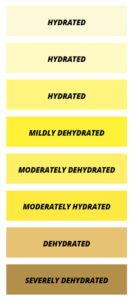
Most people don’t think about their sodium levels when it comes to hydration. We lose a lot of our important electrolytes through sweating. So be sure to drink a Gatorade every once and a while. If you do not like Gatorade or don’t want the sugar from Gatorade there are many other alternatives. So make sure if you sweat it out-replace it.

Lastly, my biggest words of advice is to stick with it and believe in yourself! You can accomplish more than you think! If you have any other questions, would like more information, or need words of encouragement feel free to email me at vmccoy@perfther.com. I wish you all the best of luck with your training and I cannot wait to run beside you at Crandic!